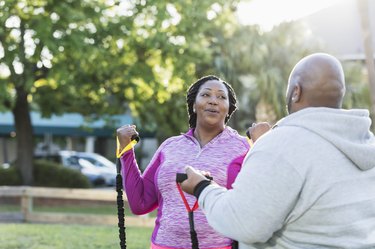
When you hear strength training, you may only think of muscle building. But this type of exercise can also help protect your joints and ease stiffness, which can be incredibly helpful for people with arthritis.
Symptoms of arthritis include pain, aching, stiffness and swelling on or near the joints. More than 1 in 4 adults with arthritis experience severe joint pain daily.
Video of the Day
Video of the Day
Since there is no cure for arthritis, managing symptoms is the main goal for those who have it, and weight lifting can help with that.
"Strength training improves muscular strength, which can decrease the pressure being distributed across the connective tissues of a joint," Evan Jay, PA-C, ATC, a certified physician assistant and certified athletic trainer with Redefine Healthcare in New Jersey, tells LIVESTRONG.com. "Proper training can lead to decreased pain and improved function."
Still, strength training may seem intimidating if you're new to this type of exercise (or it's been awhile). Here are a few tips on how to incorporate it into your regular routine.
1. Know Your Condition
First, it's important to consider the type of arthritis you have. While all types of arthritis affect the joints, the two most common forms — osteoarthritis and rheumatoid arthritis (RA) — have some key differences to keep in mind.
"RA is a common type of inflammatory arthritis that is likely due to a complex interaction of genetic factors and our environment," Joseph Martinez, MD, a rheumatologist at Texas Orthopedics, tells LIVESTRONG.com. Osteoarthritis, on the other hand, occurs when the protective tissue at the ends of bones (cartilage) wears down over time.
Although pain, stiffness and swelling are common in both, RA has a symmetrical pattern. For instance, if an exercise causes pain in your left knee, it will likely cause discomfort in your right knee, too. This is different from osteoarthritis, which causes asymmetrical pain, Jay says.
With that in mind, exercise within a range of motion that is most comfortable for you, Jay says. "Any exercise that can be tolerated is ideal as long as the technique and the necessary range of motion is attainable."
Although a little discomfort may be OK, refrain from doing any exercises that flat out hurt your joints.
2. Do a Proper Warm-Up and Cool-Down
Before starting your strength-training workout, do a warm-up to prep your muscles for their full range of motion. Skipping a warm-up can increase your likelihood for injury, Jay says.
"Warming up assures the muscles are not hindered by adhesions and are ready to receive increased signals from the nervous system and respond appropriately," explains Jay. "Assuring the muscle is ready for maximal work will allow for the greatest force across the muscle and also limit the residual force across the ligaments and cartilage structures."
Ending your workout with a cool-down helps your body go back to its normal temperature, blood pressure and heart rate. A proper cool-down also heightens the body's function, Jay says, leading to increased flexibility and less chance for injury.
Dr. Martinez recommends low-impact exercises for both your warm-up and cool-down around a strength workout. Simple activities like walking, cycling or yoga are a good fit.

3. Choose the Right Equipment for You
You don't have to lift heavy barbells to strength-train. Here are some options that will help you build muscle effectively while being kinder to your joints.
Start With No Equipment
Isometric Exercises: Isometric exercises are ideal for those with arthritis because they create tension in the muscles without changing the position of the joint that the muscle typically moves, per the Mayo Clinic. While they're not the best for building muscle, isometric exercises can help people with arthritis build joint stability and strength over time, so they can move on to other forms of strength training.
Examples of isometric exercises include planks, wall sits and many yoga poses, such as chair pose.
Body-Weight Exercises: Jay encourages body-weight exercises (think: squats, push-ups) which require no equipment and can be done just about anywhere. Don't underestimate the power of these moves — they activate multiple muscle groups at once, helping you build more muscle and burn more calories.
Add Resistance
Resistance Bands: "Resistance bands would be best suited for individuals with arthritis as they are more controllable and limit the risk of altered form and injury," Jay says. They are incredibly beneficial in helping focus your control and strengthening your muscles with greater resistance than perhaps a light weight, he notes.
Progress to Weights
Weight Machines: These are only available at gyms and fitness centers, but may be helpful to those with arthritis as they control resistance and protect against injury. This may be a great stepping-stone to light weights.
Light Weights: Light weights, such as dumbbells and kettlebells, are recommended for those who have proper lifting form, as they require more stabilization, Jay says. Safe lifting is crucial, as it prevents injury, which can be particularly harmful to people with arthritis. If used properly, light weights have a variety of benefits, including driving a greater range of motion with greater flexibility.
4. Respect Your Limits
While exercising, you may feel a little bit of discomfort or pain with the stretching of your muscles, which is OK. But if the pain gets to a point where it is not tolerable or you experience a flare-up, it is best to stop the workout.
"Generally speaking, I advise my patients to listen to their body during exercise," Dr. Martinez says. "Feeling a mild soreness during exercise is normal. However, if you're developing a clear feeling of pain, it is best to stop that exercise."
It's also important to stay in your range of motion and not over-exercise, which can put too much pressure and exertion on your joints.
"Engaging in large amounts of high-impact exercise can exacerbate pre-existing joint damage and lead to increased pain, and potentially worsen structural damage," Dr. Martinez says.
5. Consider Working With a Fitness Professional
Since arthritis is complicated and can affect people differently, it might be a good idea to work with a professional — such as a physical therapist or certified personal trainer — who has experience designing and adapting exercises for people with the condition.
"There are specific techniques that can be implemented to decrease the pressure across the aspect of the joint that is degenerative, which can result in improved ability to exercise with decreased pain," Jay says.
Was this article helpful?
150 Characters Max
0/150
Thank you for sharing!
Thank you for your feedback!
Is this an emergency? If you are experiencing serious medical symptoms, please see the National Library of Medicine’s list of signs you need emergency medical attention or call 911.